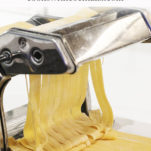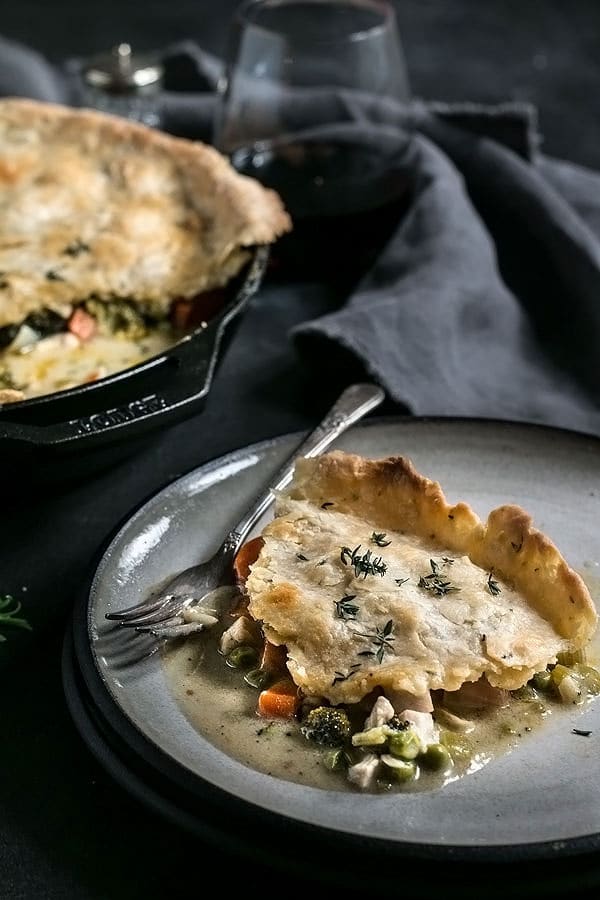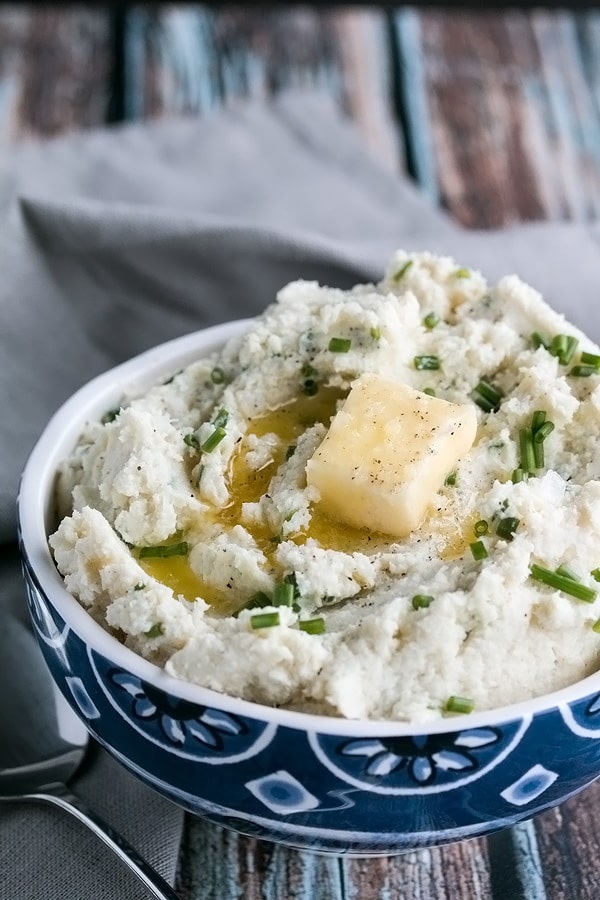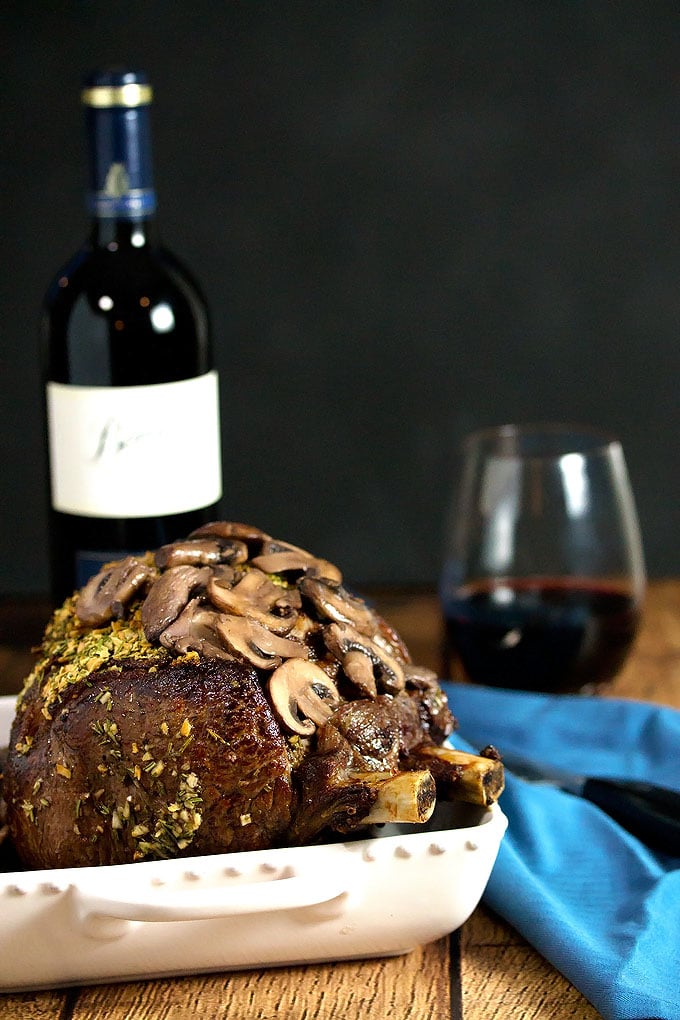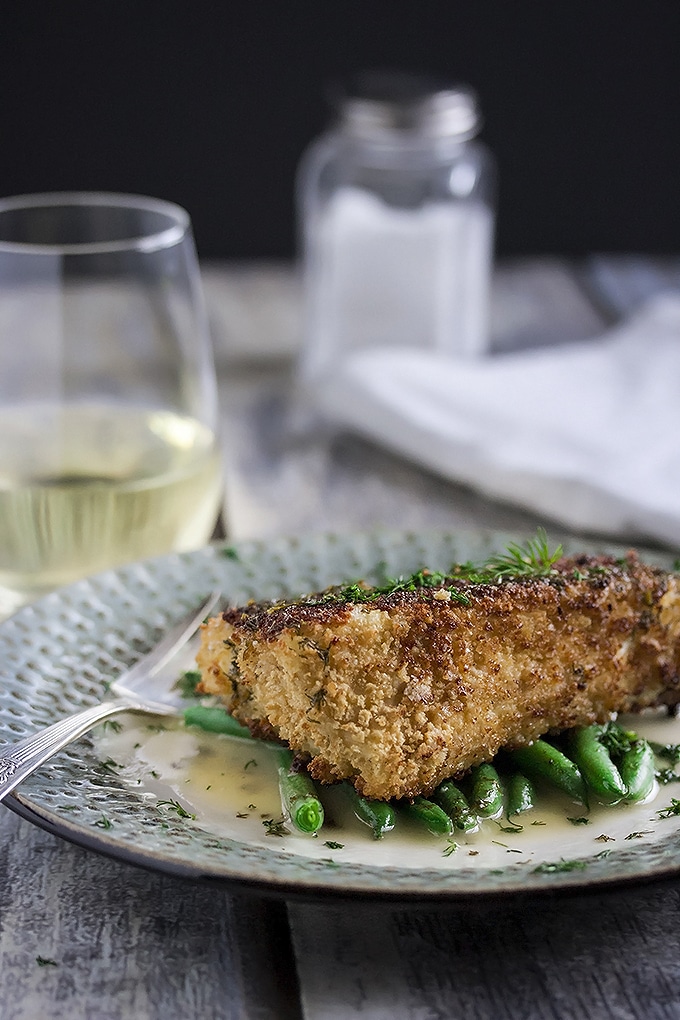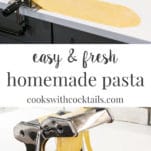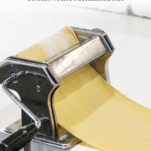Easy Fresh Homemade Pasta Recipe
Make delicious homemade pasta, fresh in your own kitchen. Its easy, tastes amazing, and it will take your pasta game to a new level.
There’s not a lot that is more satisfying than homemade pasta. The store bought “fresh” pastas are ok, but nothing compares to homemade. This is a basic pasta dough recipe that we have used many times for ravioli and fettuccine, but it would work well for any type of pasta you would like.
Truth be told, there is a small learning curve to using the pasta making machines, but you will get the hang of it quick and be cranking out pasta in no time at all.
Making your own pasta for when you have company is a sure fire way to have your guests raving about the meal. That said, we suggest practicing at least once before you do this for guests. You don’t want to be in a rush or create stress the first time.
Pasta and wine are a match made in heaven so why not drink wine while making pasta? Right?
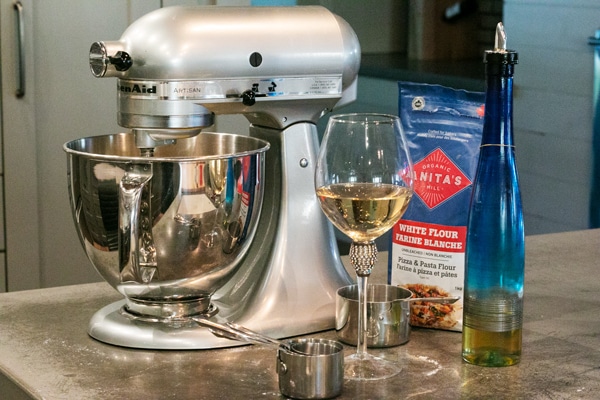
Tools You Need
- a mixer – this is optional, you can also make your dough by hand, but the mixer makes it pretty effortless.
- a simple hand crank pasta machine – this machine makes things quick and easy and its the one that I have.
- or a kitchen aid pasta roller that attaches to your mixer and you don’t have to crank it. Debbie has one. Both work great!
- pasta drying rack – we need one of these things, but you will see how we improvised below… 🙂
- ravioli maker – this one is the best in our opinion. Super easy to use.
Ingredients You Need
To make pasta dough, you only need a few ingredients:
- flour
- eggs
- oil
- salt
Best Flour for Making Pasta
I have been using Anita’s organic pizza and pasta flour for the last while and it works fantastic. Its a 00 soft white flour. Anita’s is a local company that makes a great range of organic and sprouted flours. If you have a local flour company around you, I highly recommend trying their pasta flour.
Here is another 00 soft white flour you could try. We prefer it over the semolina, but that is just our preference. Otherwise any all purpose flour will do.
Many recipes call for semolina flour which is a heartier flour and it is great if you have it and your preference is a hearty pasta. Any flour will do except we don’t recommend using cake and pastry flour.

Mixing the Dough
You can mix the dough by hand or you can use your mixer. I use my mixer because it does take a little bit of kneeding to get the dough smooth and its easy with the machine. Totally doable by hand though.
Mixing pasta dough with a mixer
- add your flour, salt, eggs and just a touch of oil to the mixer
- use the dough hook and mix
- let the mixer knead the dough until it is nice and smooth and all tucked in a nice ball.
- wrap it in plastic wrap or beeswax wrap and rest it in the fridge.
Mixing pasta dough by hand
- measure your flour and dump it onto a flat surface with some room. Make a well in the center of your flour.
- add the eggs, salt and a touch of oil to the well.
- mix up the eggs, salt and oil with a fork
- using your fork or your fingers, start bringing the flour into the well and mix it with your egg mixture. Keep doing this until all the flour is mixed in and you have a craggly dough.
- then you must knead! Knead the dough for about 10 mins until your dough gets nice and smooth.
- wrap it in plastic wrap or beeswax wrap and rest it in the fridge.
Tips for Making the Dough
- don’t add water or more liquid! If the dough seems dry at first, thats ok. Just start kneading. If after 5 mins in the mixer or 10 mins by hand, the dough still is craggly and dry then add just a touch of water or oil.
- if you add water, spraying with a bottle mister works the best. That way you don’t get too much and its dispersed nicely.
- remember that this dough is meant to be quite stiff.
Resting the Dough
Either way you mix your dough, you must rest it for about 30 mins before you roll out your pasta. Resting allows the gluten to relax and the flour to hydrate completely.
Resting makes for a much easier time when you roll the dough. Rest for 30 mins up to 2 days.
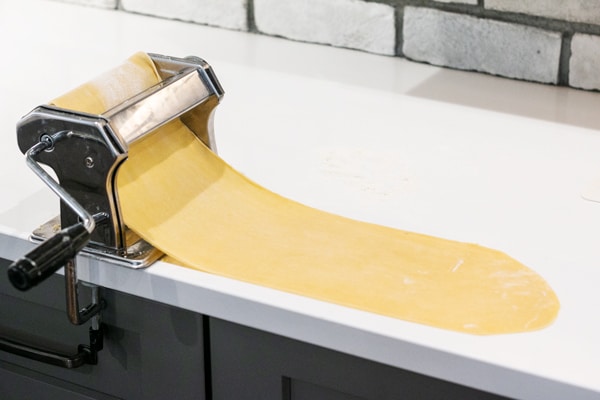
How to Roll Your Pasta
Alright. We are ready to roll! Don’t get frustrated if at first, things seem a little awkward and tricky. You will get the hang of it quick. Soon, you will think its easy! I promise.
Take your dough out of the fridge, unwrap it and cut it into quarters. Take one quarter to roll and rewrap the rest. It can dry out quick if you don’t keep it wrapped. When your pasta roller is ready, make sure you have some extra flour on hand and then this is how you proceed:
- lightly dust the dough with flour before you try to roll
- roll through level 1 a couple times before going to the next number
- fold the dough into a rectangle after the first pass to try to make it a little more rectangle in shape (this is optional)
- change to level 2 on the roller and roll through
- keep going up a level on the roller until you have your desired thickness.
For spaghetti, linguine, fettuccine and lasagna noodles, don’t go past level 5 or 6. (if your roller has 7 settings like mine). For ravioli, I go all the way to 7 so my layers are thin.
If you are cutting your pasta into noodles, you will usually need to add an attachment to your roller. My hand crank roller has an attachment that fits on when you are ready to cut. Debbie’s kitchen aid one has to be changed out for the cutter. They don’t fit together.
When you cut your pasta, you just take your thin sheet and run it through the machine and bang, your done.
Hang your pasta to dry slightly before cooking or if you are planning to store it. You can get a nice little pasta drying rack like this one, or you can improvise like we did 🙂
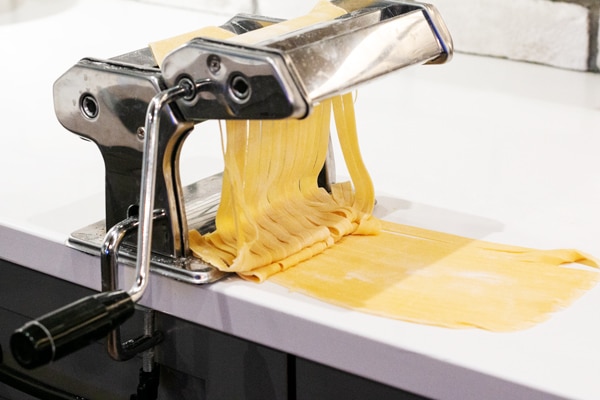
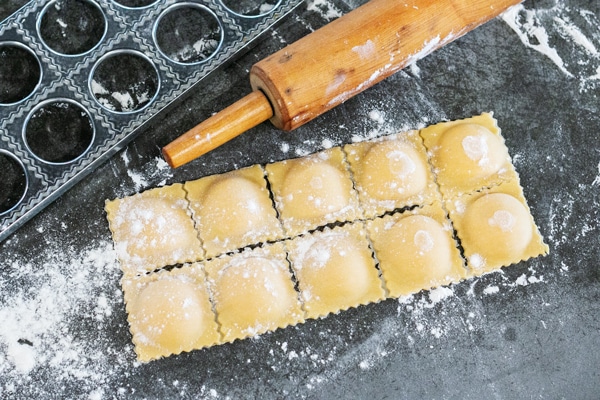
Tips For Rolling Your Pasta
- Slightly flour your pasta roller before you start rolling the pasta. This will help it not stick.
- If your pasta sticks to the machine, dust it with flour again. It means its too sticky.
- Pasta must be thin. If its not thin, it will take a long time to dry and it can get clumpy when you cook it. But not too thin!
- Don’t wash your pasta machine. Leave the flour on it for next time.
- When making noodles, you might want to cut your thin sheets in half before cutting so you don’t end up with extra long noodles like I did.
How to Cook Fresh Pasta
This is the easy part! Boil some water, salt it generously, add your pasta and they will be done in 1 – 3 mins. They cook quick! I usually cook mine for about 2 to 2.5 mins. Don’t cook much longer or they will get mushy.
Drain the noodles and add to your sauce!
Storing Pasta Dough
You can store your pasta a few ways. If you haven’t rolled it out, you can wrap the unused dough and store in the fridge for up to 3 days or in the freezer for up to 2 months.
If you have cut your pasta and you didn’t use it all, you will want to dry your pasta for about an hour. Then transfer it gently to an airtight container and store in the fridge for up to 3 days or in the freezer for up to 2 months. Dry it on a pasta dryer or like we did below. I’m sure they do this in Italy, no?
And there you have it. You have made pasta! Just wait till everyone goes crazy for it when they dig in!
Yes, I am still drinking wine…
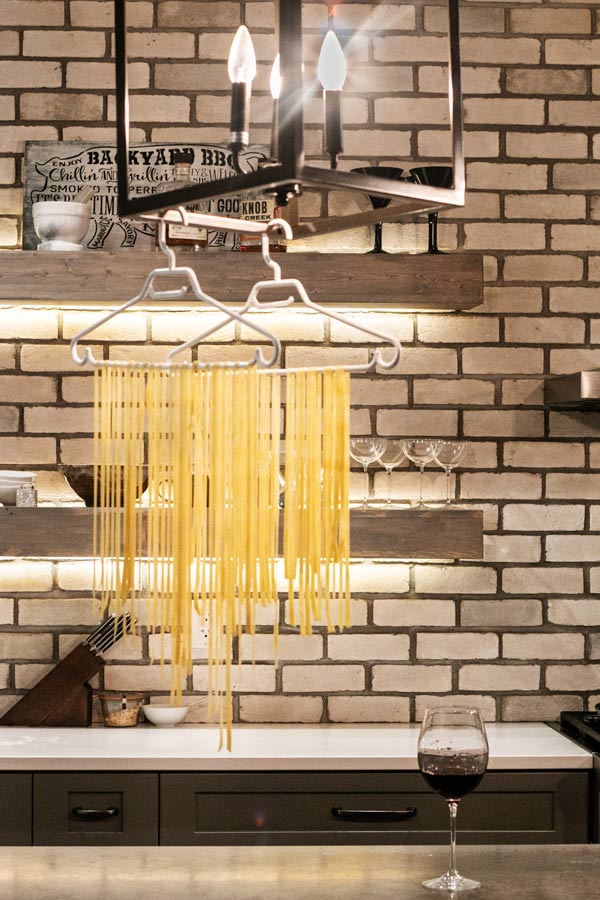
Homemade Pasta Recipes to Try
- Butternut Squash Ravioli
- Asparagus & Lemon Pasta Fonduta with Pan Fried Scallops
- Sausage, Spinach and Wine Fettuccine Recipe
- Short Rib Ravioli with Truffle Sauce
- Mushroom Ravioli with Limoncello Sauce
- Salmon Pasta Chowder
If you’ve tried this fresh homemade pasta dough recipe then we would love it if you could rate the recipe by clicking on the stars in the recipe card and let us know how it turned out in the comments below. We love hearing from you!
We also love to see your creations! Tag @Cookswithcocktails if you post a picture of this recipe on INSTAGRAM
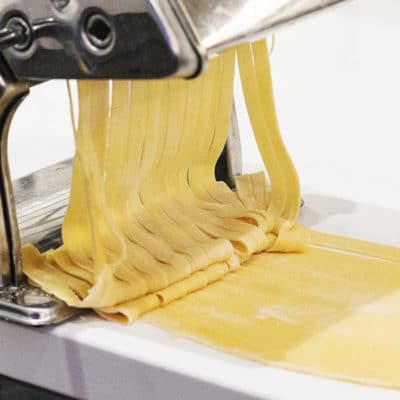
Fresh Homemade Pasta
Instructions
- With a mixer and a dough hook, add the flour and salt add mix for a second. Then add the oil and 1 egg at a time while mixing. Mix until the dough forms a ball. Knead till smooth and then cover and let rest for 30 mins. You can remove from the mixer and kneed with your hands too if you like. Wrap in plastic wrap and store in the fridge until you are ready to make the pasta.
- Cut dough in quarters and cover the rest so it doesn’t dry out. Flour the counter and press flat to put in the pasta machine on the widest setting, do this 2 or 3 times then after turn the dial to the next setting getting thinner as your turn the dial my machine starts at 1 and I go to 4 on the dial.
- Once you have a thin sheet of pasta, cut or shape the pasta in whatever form you desire.
Mixing pasta dough with a mixer
- Add your flour, salt, eggs and just a touch of oil to the mixer, Use the dough hook and mix. Let the mixer knead the dough until it is nice and smooth and all tucked in a nice ball. Wrap it in plastic wrap or beeswax wrap and rest it in the fridge.
Mixing pasta dough by hand
- Measure your flour and dump it onto a flat surface with some room. Make a well in the center of your flour. add the eggs, salt and a touch of oil to the well. Mix up the eggs, salt and oil with a fork. Using your fork or your fingers, start bringing the flour into the well and mix it with your egg mixture. Keep doing this until all the flour is mixed in and you have a craggly dough. Then you must knead! Knead the dough for about 10 mins until your dough gets nice and smooth. Wrap it in plastic wrap or beeswax wrap and rest it in the fridge.
Resting the Dough
- Either way you mix your dough, you must rest it for about 30 mins before you roll out your pasta. Resting allows the gluten to relax and the flour to hydrate completely.
Roll Your Pasta
- Take your dough out of the fridge, unwrap it and cut it into quarters. Take one quarter to roll and rewrap the rest. It can dry out quick if you don't keep it wrapped. When your pasta roller is ready, make sure you have some extra flour on hand.
- Lightly dust the dough with flour before you try to roll. Roll through level 1 a couple times before going to the next number. Fold the dough into a rectangle after the first pass to try to make it a little more rectangle in shape (this is optional). Change to level 2 on the roller and roll through. Keep going up a level on the roller until you have your desired thickness.
- For spaghetti, linguine, fettuccine and lasagna noodles, don't go past level 5 or 6. (if your roller has 7 settings like mine). For ravioli, I go all the way to 7 so my layers are thin. If you are cutting your pasta into noodles, you will usually need to add an attachment to your roller. My hand crank roller has an attachment that fits on when you are ready to cut. Debbie's kitchen aid one has to be changed out for the cutter. They don't fit together.
- When you cut your pasta, you just take your thin sheet and run it through the machine and bang, your done. Hang your pasta to dry slightly before cooking or if you are planning to store it.
Cook the Pasta
- This is the easy part! Boil some water, salt it generously, add your pasta and they will be done in 1 – 3 mins. They cook quick! I usually cook mine for about 2 to 2.5 mins. Don't cook much longer or they will get mushy. Drain the noodles and add to your sauce!
Notes
- Don’t add water or more liquid!
- If the dough seems dry at first, thats ok. Just start kneading. If after 5 mins in the mixer or 10 mins by hand, the dough still is craggly and dry then add just a touch of water or oil.
- If you add water, spraying with a bottle mister works the best. That way you don’t get too much and its dispersed nicely.
- Remember that this dough is meant to be quite stiff.
- Slightly flour your pasta roller before you start rolling the pasta. This will help it not stick.
- If your pasta sticks to the machine, dust it with flour again. It means its too sticky.
- Pasta must be thin. If its not thin, it will take a long time to dry and it can get clumpy when you cook it. But not too thin!
- Don’t wash your pasta machine. Leave the flour on it for next time.
- When making noodles, you might want to cut your thin sheets in half before cutting so you don’t end up with extra long noodles like I did.

